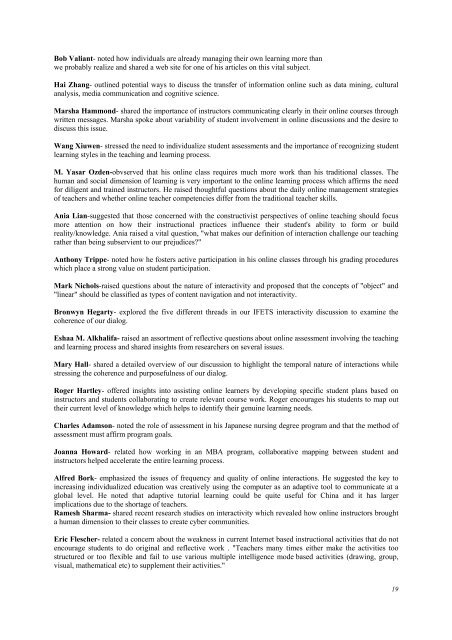Complete issue in PDF - Educational Technology & Society
Complete issue in PDF - Educational Technology & Society
Complete issue in PDF - Educational Technology & Society
Create successful ePaper yourself
Turn your PDF publications into a flip-book with our unique Google optimized e-Paper software.
Bob Valiant- noted how <strong>in</strong>dividuals are already manag<strong>in</strong>g their own learn<strong>in</strong>g more than<br />
we probably realize and shared a web site for one of his articles on this vital subject.<br />
Hai Zhang- outl<strong>in</strong>ed potential ways to discuss the transfer of <strong>in</strong>formation onl<strong>in</strong>e such as data m<strong>in</strong><strong>in</strong>g, cultural<br />
analysis, media communication and cognitive science.<br />
Marsha Hammond- shared the importance of <strong>in</strong>structors communicat<strong>in</strong>g clearly <strong>in</strong> their onl<strong>in</strong>e courses through<br />
written messages. Marsha spoke about variability of student <strong>in</strong>volvement <strong>in</strong> onl<strong>in</strong>e discussions and the desire to<br />
discuss this <strong>issue</strong>.<br />
Wang Xiuwen- stressed the need to <strong>in</strong>dividualize student assessments and the importance of recogniz<strong>in</strong>g student<br />
learn<strong>in</strong>g styles <strong>in</strong> the teach<strong>in</strong>g and learn<strong>in</strong>g process.<br />
M. Yasar Ozden-obvserved that his onl<strong>in</strong>e class requires much more work than his traditional classes. The<br />
human and social dimension of learn<strong>in</strong>g is very important to the onl<strong>in</strong>e learn<strong>in</strong>g process which affirms the need<br />
for diligent and tra<strong>in</strong>ed <strong>in</strong>structors. He raised thoughtful questions about the daily onl<strong>in</strong>e management strategies<br />
of teachers and whether onl<strong>in</strong>e teacher competencies differ from the traditional teacher skills.<br />
Ania Lian-suggested that those concerned with the constructivist perspectives of onl<strong>in</strong>e teach<strong>in</strong>g should focus<br />
more attention on how their <strong>in</strong>structional practices <strong>in</strong>fluence their student's ability to form or build<br />
reality/knowledge. Ania raised a vital question, "what makes our def<strong>in</strong>ition of <strong>in</strong>teraction challenge our teach<strong>in</strong>g<br />
rather than be<strong>in</strong>g subservient to our prejudices?"<br />
Anthony Trippe- noted how he fosters active participation <strong>in</strong> his onl<strong>in</strong>e classes through his grad<strong>in</strong>g procedures<br />
which place a strong value on student participation.<br />
Mark Nichols-raised questions about the nature of <strong>in</strong>teractivity and proposed that the concepts of "object" and<br />
"l<strong>in</strong>ear" should be classified as types of content navigation and not <strong>in</strong>teractivity.<br />
Bronwyn Hegarty- explored the five different threads <strong>in</strong> our IFETS <strong>in</strong>teractivity discussion to exam<strong>in</strong>e the<br />
coherence of our dialog.<br />
Eshaa M. Alkhalifa- raised an assortment of reflective questions about onl<strong>in</strong>e assessment <strong>in</strong>volv<strong>in</strong>g the teach<strong>in</strong>g<br />
and learn<strong>in</strong>g process and shared <strong>in</strong>sights from researchers on several <strong>issue</strong>s.<br />
Mary Hall- shared a detailed overview of our discussion to highlight the temporal nature of <strong>in</strong>teractions while<br />
stress<strong>in</strong>g the coherence and purposefulness of our dialog.<br />
Roger Hartley- offered <strong>in</strong>sights <strong>in</strong>to assist<strong>in</strong>g onl<strong>in</strong>e learners by develop<strong>in</strong>g specific student plans based on<br />
<strong>in</strong>structors and students collaborat<strong>in</strong>g to create relevant course work. Roger encourages his students to map out<br />
their current level of knowledge which helps to identify their genu<strong>in</strong>e learn<strong>in</strong>g needs.<br />
Charles Adamson- noted the role of assessment <strong>in</strong> his Japanese nurs<strong>in</strong>g degree program and that the method of<br />
assessment must affirm program goals.<br />
Joanna Howard- related how work<strong>in</strong>g <strong>in</strong> an MBA program, collaborative mapp<strong>in</strong>g between student and<br />
<strong>in</strong>structors helped accelerate the entire learn<strong>in</strong>g process.<br />
Alfred Bork- emphasized the <strong>issue</strong>s of frequency and quality of onl<strong>in</strong>e <strong>in</strong>teractions. He suggested the key to<br />
<strong>in</strong>creas<strong>in</strong>g <strong>in</strong>dividualized education was creatively us<strong>in</strong>g the computer as an adaptive tool to communicate at a<br />
global level. He noted that adaptive tutorial learn<strong>in</strong>g could be quite useful for Ch<strong>in</strong>a and it has larger<br />
implications due to the shortage of teachers.<br />
Ramesh Sharma- shared recent research studies on <strong>in</strong>teractivity which revealed how onl<strong>in</strong>e <strong>in</strong>structors brought<br />
a human dimension to their classes to create cyber communities.<br />
Eric Flescher- related a concern about the weakness <strong>in</strong> current Internet based <strong>in</strong>structional activities that do not<br />
encourage students to do orig<strong>in</strong>al and reflective work . "Teachers many times either make the activities too<br />
structured or too flexible and fail to use various multiple <strong>in</strong>telligence mode based activities (draw<strong>in</strong>g, group,<br />
visual, mathematical etc) to supplement their activities."<br />
19
















